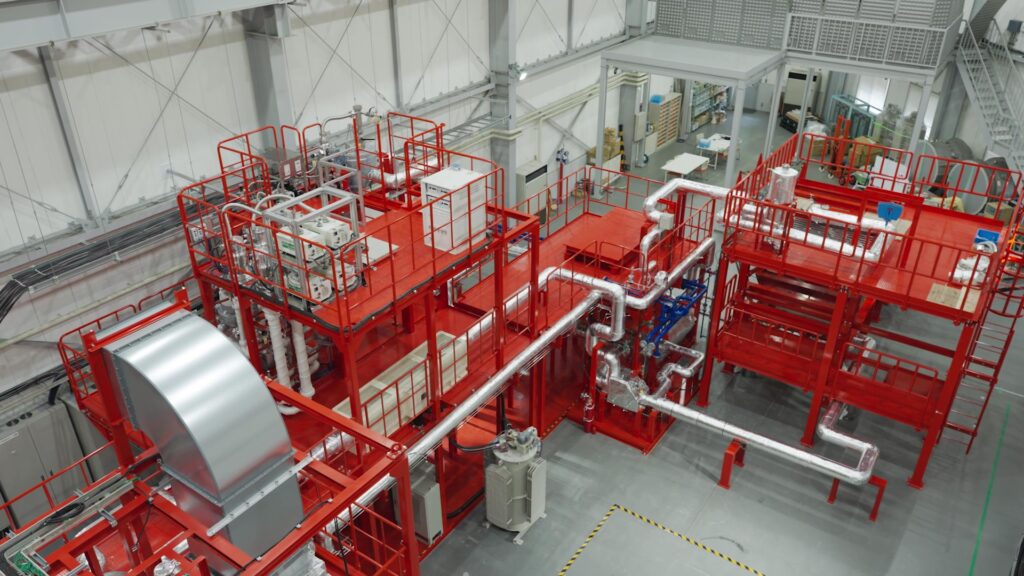Video Showcases Liquid Metal Power Generation and Hydrogen Isotope Separation Technologies
Kyoto Fusioneering Ltd. (KF), a company dedicated to the engineering of fusion energy systems, has released a new video on UNITY-1, an integrated blanket and thermal cycle facility based in Kyoto, designed to demonstrate key fusion power generation technologies.
Under final stages of building and commissioning, and having begun partial operations, UNITY-1 is designed to demonstrate how thermal energy from a fusion machine can be converted into electricity, a crucial step toward practical fusion power. The facility simulates fusion power plant conditions, such as magnetic fields of up to 4 Tesla and temperatures up to 1,000°C, allowing KF to validate key technologies in a controlled and relevant environment.
The video introduces two core technologies to be tested at UNITY-1:
- A liquid metal-based heat transfer and power generation system, which forms the backbone of the fusion blanket and thermal cycle system—a process that extracts high-temperature heat from a fusion environment and converts it into usable energy.
- The Vacuum Sieve Tray (VST), an innovative system designed to separate hydrogen isotopes, including tritium, from liquid metals or molten salts—an essential function for closing the fuel cycle of a commercial fusion power plant.
In addition to highlighting these advanced systems, the video also outlines KF’s ongoing development efforts and long-term vision for advancing fusion power from concept to reality.
1. UNITY-1 Overview
Kyoto Fusioneering is pioneering the development of an integrated blanket and thermal cycle facility, a critical system for extracting energy from the core of a fusion energy plant and converting it into electricity or other useful forms.
In this system, high-energy neutrons produced by fusion reactions are absorbed by a structural component called a blanket, which captures intense heat reaching temperatures of up to 1,000°C. This heat is then transported using liquid metal as a heat transfer medium and used for power generation and hydrogen production.
To test and validate this technology, KF began construction of the UNITY-1 integrated test plant in Kyoto in 2024. While UNITY-1 does not use actual fusion reactions, it creates a simulated high-temperature and high magnetic field environment under fusion-relevant conditions to demonstrate the full thermal-to-electric power conversion process.
To maximize the efficient use of high-temperature energy generated in fusion environments, UNITY-1 employs lithium-lead (LiPb) as its liquid metal coolant. While we operate smaller coolant systems for molten salts (FLiBe) and pure lithium (Li), lithium-lead has shown to be an ideal material for this application, offering excellent thermal conductivity and chemical stability, along with the unique ability to breed tritium, a critical fuel for fusion reactions. These properties make it indispensable to the development of the fusion blanket and thermal cycle.
At UNITY-1, KF is building a system capable of recovering heat at temperatures up to 1,000°C using lithium-lead and advanced structural materials engineered to withstand extreme thermal stress.
To ensure reliable and efficient operations, the plant incorporates a custom-designed engineered piping layout that prevents stagnation of lithium-lead by accounting for both fluid dynamics and thermal stress caused by large temperature gradients. A specialized insulation system is also in place to minimize heat loss—designs tailored specially to meet the demanding conditions of a fusion energy plant.
Construction of UNITY-1’s large-scale system components—excluding the heat exchanger and power generation turbine—has already been completed, thanks to the support of our highly skilled manufacturing partners in Japan.
While liquid metal-based heat recovery has been used in fast reactors, it remains a globally sought-after technology, particularly in the context of fusion energy. Demonstrating its feasibility under the unique and demanding conditions of fusion energy plants requires overcoming significant challenges in system design, structural integrity, and advanced manufacturing.
A key research focus is understanding how liquid metal behaves in strong magnetic fields, which are inherent to magnetic fusion environments. To address this, KF is conducting flow tests using superconducting magnets capable of generating magnetic fields up to 4 Tesla—a groundbreaking initiative.
With testing and construction progressing in parallel, KF is on track to demonstrate liquid metal-based power generation technology.

2. Demonstration Tests Conducted at UNITY-1
To date, KF has successfully conducted a series of tests at UNITY-1 as part of its effort to validate key technologies for fusion energy systems. These include heating liquid metal to 500°C and circulating it through the system to simulate the conditions found in fusion power plants. Preparations are also underway for upcoming tests that will verify whether the liquid metal flows as expected under strong magnetic fields generated by superconducting magnets, simulating the environment inside a fusion core. All testing to date has progressed in line with design expectations.
Looking ahead, KF plans to install a heat exchanger that will transfer the 500°C heat from the liquid metal to air, followed by the installation of a power generation turbine that uses the heated air to generate electricity. Together, these systems will enable the full demonstration of liquid metal-based power generation technology at UNITY-1.
In the longer term, KF aims to demonstrate heat transport at temperatures up to 1,000°C, aligning with the energy output expected from future commercial fusion reactions.
In addition to power generation testing, UNITY-1 is also being used to validate Vacuum Sieve Tray (VST) technology, which plays a critical role in extracting hydrogen isotopes such as tritium—a key function of the blanket system in fusion power plants, where tritium is bred.
Although tritium is not used in current tests, UNITY-1 circulates liquid metal containing deuterium through the VST, where it forms droplets. This process enables the recovery of hydrogen isotopes, specifically a mixture of tritium and deuterium gases, from the liquid metal.
KF plans to conduct performance evaluation tests to assess the efficiency of fusion fuel recovery, further demonstrating the system’s potential to support a fully integrated fusion fuel cycle.
3. UNITY Program: Integrated Testing of Critical-Path Technologies
Two core technologies are essential for developing a commercially viable fusion energy plant:
- The fusion blanket and thermal cycle system, which breeds fuel and extracts energy produced by fusion reactions and converts it into usable forms like electricity and heat
- The fusion fuel cycle system, which enables the recovery, separation, and recycling of fusion fuel, allowing for continuous, self-sustaining fusion reactions
These systems are essential to the practical deployment of fusion energy, regardless of the plasma confinement method used, whether magnetic confinement, inertial confinement, or hybrid concepts. While sustaining fusion reactions is a major milestone, the real challenge lies in efficiently capturing, converting, and managing that energy to make fusion a reliable energy source for society. UNITY-1 plays a key role in advancing these technologies through integrated, real-world testing in a simulated fusion environment.
As part of its broader mission to make fusion energy a viable power source, KF launched the UNITY Program in 2022 to conduct integrated testing of critical fusion systems and components.
To accelerate development, the project has since evolved into two complementary initiatives:
- UNITY-1, focused on demonstrating the fusion blanket and thermal cycle system, which extracts and converts energy from the fusion process
- UNITY-2, aimed at validating the fusion fuel cycle system, which enables the continuous support of fuel to the fusion core.
Unlike UNITY-1, which operates without actual fusion reactions, UNITY-2 will use fusion fuels—deuterium and tritium—in its testing. To enable this, KF has established a joint venture called Fusion Fuel Cycles Inc. in partnership with Canadian Nuclear Laboratories (CNL), one of the world’s leading nuclear research institutions. Construction of the UNITY-2 facility is currently underway in Ontario, Canada.
Kyoto Fusioneering will continue to accelerate the development of critical technologies for fusion energy plants. Through integrated testing at UNITY-1 and UNITY-2, we are tackling key technical challenges and moving closer to the deployment of practical, commercial-scale fusion power.




